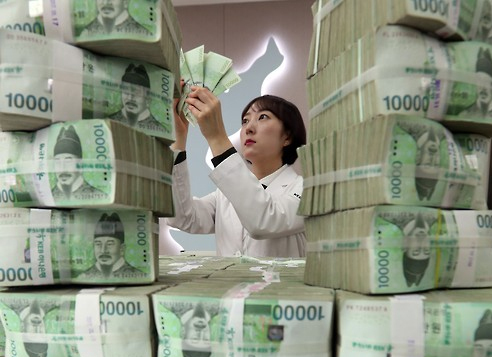Commercial lenders in South Korea have raised interest rates for household lending, weighing on household debt, the central bank’s data showed Sunday.
Fresh household loans with rates lower than 3 percent, extended by local banks, took up 26 percent of total household loans in March, hitting a 25-month low, according to data from the Bank of Korea.
The proportion of new loans with interest rates below 3 percent plummeted by 50 percentage points to reach 25.8 percent, from 76 percent in August 2016, according to the data.
More lenders began to offer household loans with higher rates instead.
Fresh household loans with rates lower than 3 percent, extended by local banks, took up 26 percent of total household loans in March, hitting a 25-month low, according to data from the Bank of Korea.
The proportion of new loans with interest rates below 3 percent plummeted by 50 percentage points to reach 25.8 percent, from 76 percent in August 2016, according to the data.
More lenders began to offer household loans with higher rates instead.

Loans with rates at between 3-4 percent made up 63.5 percent of new loans in March. The proportion of household loans offered at interest rates of above 5 percent rose to 4.9 percent in March from 2.9 percent in August.
The local banking industry’s move to raise interest rates took shape months before the US Federal Reserve raised its key rate by 0.25 percent in December 2016. A Fed rate hike took place in March again, by another 0.25 percent. Meanwhile, the BOK’s benchmark rate has remained steady at 1.25 percent for 10 months to date.
Another set of data from the BOK on Wednesday showed that a new household loan’s average interest rates at local lenders came to 3.43 percent and a mortgage loan’s average was at 3.21 percent as of March.
The average mortgage rate in March was the highest in 25 months, the data showed.
In March, the difference between the loan and deposit interest rates was at 1.99 percent, the highest in more than four years since January 2013, excluding January this year when it was at 2 percent, according to the BOK.
Many banks in South Korea reported a surge in net profits in the first quarter. Revenues from interest at the four largest local banks -- Shinhan Bank, Kookmin Bank, KEB Hana Bank and Woori Bank -- rose on-year in the first quarter.
The rise in household lending rates, as well as the widening gap between the loan and deposit interest rates, have put continued pressure on household debt here and dampened household consumption, the BOK noted earlier in a report released April 13.
“The rise in loan interest rates in the wake of the Fed rate hikes is posing a heavier challenge on household debtor’s ability to pay back loans,” the BOK said.
Outstanding household credit -- comprising household loans and credit card spending -- reached 1,344.3 trillion won ($1.2 trillion) at the end of 2016, up 11.7 percent from the previous year.
By Son Ji-hyoung (consnow@heraldcorp.com)



















![[Today’s K-pop] BTS pop-up event to come to Seoul](http://res.heraldm.com/phpwas/restmb_idxmake.php?idx=642&simg=/content/image/2024/04/17/20240417050734_0.jpg&u=)